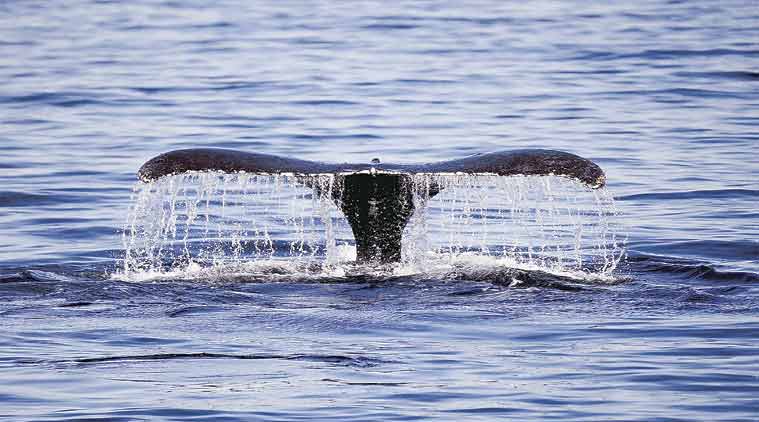 They are developing a method to detect and localise whales
They are developing a method to detect and localise whales
IT IS an indecipherable call. It has popped up every year for the past 15 years, around the same month, but for the two IIT-Madras engineers listening in, they “don’t know where it is coming from” — or how much the thing, speaking this tongue, weighs.
“We are picking up a very strong call, in the entire dataset,” Nikita Pinto, MS student at the IIT’s department of ocean engineering, told The Indian Express. “Every year, it turns up at the same month. We don’t really know which whale is making this sound. We can’t find it in previous published literature but it is a distinct sound.”
Pinto and her colleague, assistant professor Tarun K Chandrayadula, are tracing migratory patterns of baleen whales, among the largest animals on earth, across the Indian Ocean to build a “whale atlas.”
Borrowing acoustic signals recorded by CTBTO, the comprehensive nuclear-test-ban treaty organisation, which monitors nuclear testing across the world, the two have just begun a research project to map whales in the region.
“We use the vast recordings from the CTBTO network to get the acoustic data. These hydrophones are deployed in groups of three, and are referred to as triads. These triads are currently in place at Diego Garcia (central Indian Ocean), Cape Leuwin (Western Australia), and Crozet Islands (close to Antarctica),” says Chandrayadula.
Though the hydrophones that record low frequency sounds from less than 10Hz to up to 100 Hz are only a few in number, low frequency sounds travel far in the deep ocean. “They propagate up to thousands of kilometres, because of a special waveguide property of the ocean,” he says.
The two engineers are working with recordings since the early 2000s. “A big contributor to the background spectrum are sounds made by fin whales, and blue whales. These animals make these sounds while scouring long distances across the ocean basins, looking for mates and food,” says Chandrayadula.
The blue whale, and fin whale populations are currently endangered. “Acoustics is thus a vital part of their life cycle. We are currently using these acoustic recordings to track the whales, their migratory patterns, and their potential relationship to changing oceanic conditions,” he says.
Pinto summarises their work by saying they are developing a method to detect and localise whales. “This field of marine mammal bio-acoustics, is mostly dominated by people who are biologists and in this case marine biologists who are, looking at data and trying to make inferences and predictions about what is going to happen and how they (whales) are going to change their behaviour,” she says.
“We are looking at this more from an engineering-math angle, rather than how whales are behaving. It would be interesting to see how our work and the outcome of that could help marine biologists, conservation policy experts and even help better map shipping routes that avoid places where whales congregate,” says Pinto.
Mapping the whales is important for conservation. “If we know the position of the whales at different times of the year, we know where their habitats are, which conservationists can use. Population estimation is a key part of conservation efforts,” says Chandrayadula. “By tracking these animals we should be able to separate the sounds in location, so that we know if it is the same animal making sounds at a higher level, or actually different animals.”
However, there are challenges. Locating a moving animal across the ocean basin is a difficult problem, he says. “This problem involves various other issues such as building mathematical models for whale sounds, understanding how low frequency sounds travel, the relationship of the changing oceanography (across time, and distance), and finally a system that will incorporate these in to a tracking framework that will give us estimates of the locations across depth and range,” he says.
For now, the focus is entirely on the Indian Ocean. “For instance, we don’t even know if we have covered and understood all the whale species in this region,” says Pinto.
In February, 2017, a Sri Lankan marine biologist Asha de Vos documented an “unusually coloured, small baleen whale” off the southern coast of Sri Lanka. It turned out to be the first record of the little-known Omura’s whale in the region.
Pinto says: “The way people have been looking at datasets previously has been by breaking it up into little chunks, looking at just a few months. If we look at over 15 years, one thing we noticed is that whale calls are changing in their nature. Is this because ambient ocean noise itself has increased over the years?”
Ask Chandrayadula about what these indicate and he says: “We have also noticed from our analysis that the Sri Lankan blue whales are signing at a consistently lower pitch than they were at the start of 2000s. Is this due to increasing ocean acidity, or background noise, we do not know. But the animal has changed its behaviour over the past 15 years, but what is it in response with, we do not know.”
For now, he can only guess what that distinct sound is about. “The call can potentially be from the Northern Indian Ocean whale, which stays close to our waters. We want to find out more.”